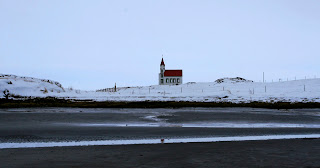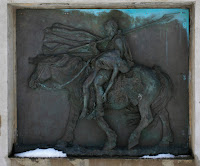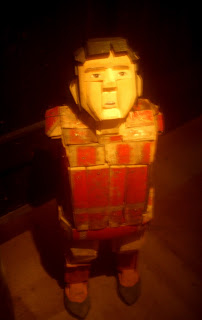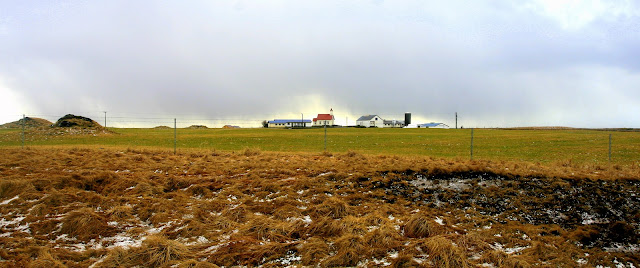 The year is 891 CE and Skalla-Grímr Kveld-Úlfsson ('Baldheaded-Grímr, son of Evening-Wolf') sails to Iceland from Norway. Skalla-Grímr's father, Kveld-Úlfr (so called because he is a shapeshifter, his human characteristics being taken over by wolfish ones when the evening draws in), sails in convoy but becomes weaker and weaker from post-berserkr exhaustion as the ships approach the new land. Kveld-Úlfr orders a companion on his ship: 'Þér skuluð bera kveðju mína Grími syni mínum, þá er þér finnizk, ok segið honum þat með, ef svá verðr, at hann kemr til Íslands, ok beri svá at, þótt þat muni ólíkligt þykkja, at ek sjá þar fyrir, þá taki hann sér þar bústað sem næst því, er ek hefi at landi komit' (Egils saga Skalla-Grímssonar, ed. Sigurður Nordal, Íslenzk fornrit II (Reykjavík, 1933), ch. 27, p. 71; 'You shall bear my greetings to my son Grímr, when you find each other, and tell him this too, if it happens that he comes to Iceland, and if it turns out that -- although it seems unlikely -- I am there ahead of him, then he shall settle in the place next to where I have come to land').
The year is 891 CE and Skalla-Grímr Kveld-Úlfsson ('Baldheaded-Grímr, son of Evening-Wolf') sails to Iceland from Norway. Skalla-Grímr's father, Kveld-Úlfr (so called because he is a shapeshifter, his human characteristics being taken over by wolfish ones when the evening draws in), sails in convoy but becomes weaker and weaker from post-berserkr exhaustion as the ships approach the new land. Kveld-Úlfr orders a companion on his ship: 'Þér skuluð bera kveðju mína Grími syni mínum, þá er þér finnizk, ok segið honum þat með, ef svá verðr, at hann kemr til Íslands, ok beri svá at, þótt þat muni ólíkligt þykkja, at ek sjá þar fyrir, þá taki hann sér þar bústað sem næst því, er ek hefi at landi komit' (Egils saga Skalla-Grímssonar, ed. Sigurður Nordal, Íslenzk fornrit II (Reykjavík, 1933), ch. 27, p. 71; 'You shall bear my greetings to my son Grímr, when you find each other, and tell him this too, if it happens that he comes to Iceland, and if it turns out that -- although it seems unlikely -- I am there ahead of him, then he shall settle in the place next to where I have come to land'). On his death, Kveld-Úlfr's coffin is thrown overboard following his final instructions. The coffin is washed into the fjord now known as Borgarfjörður -- and the place where it is driven ashore, and where it is subsequently interred after being found, is known afterwards as Kveldúlfshöfði ('Kveldúlfr's headland'). The place where Skalla-Grímr's ship took land was named Knarrarnes ('Merchant-ship headland'), one of the larger islands of the hundreds of skerries that pepper the sea to the east of the Mýrar peninsula, described by W. G. Collingwood as 'a romantic fringe of ness and voe' (W. G. Collingwood, Pilgrimage, p. 56; photo of Collingwood below).
 |
| W. G. Collingwood on horseback, Iceland 1897 |
Thus Skalla-Grímr 'built a house at Borg, one of the highest of the castle-like holts that rise above the mires ... We can stand on Egil's Borg and see in the sunset to northward, above wide rolling grass land, a long range of peaks from Eiríks-jökul and Baula to Snæfell fifty miles over the bay. To the south, close at hand, rises Hafnar-fjall, steep and scarred, above the blue fjord and rocky Borgarnes.' (Collingwood, Pilgrimage, p. 56, 59). There was no sunset to illuminate the mountains along the Snæfellsnes peninsula during the days I spent exploring Mýrar with Egils saga in hand: snow had buried the land and constant clouds concealed the mountains to the north and east. Nor was there much evidence of the Eden-like abundance of flora and fauna that, according to the saga, the new settlers discovered, and from which many of the names these men bestowed on places derive: 'var þar mýrlendi mikit ok skógar víðir, langt í milli fjalls ok fjöru, selveiðar gnógar ok fiskfang mikit ... fundu þeir þar andir margar ok kölluðu Andakíl ... þá kómu þeir á nes eitt lítit ok veiddu þar álptir nökkurar ok kölluðu Álptanes' (Egils saga, pp. 72-72; 'there was a great expanse of moor-land and it was widely-forested, a great distance between the mountains and the shore, plentiful seal-hunting and great stores of fish ... they found many ducks there [in one place] and called it Andakíll ('Duck-inlet') ... then then came to a certain small headland and hunted some swans there and called it Álptanes ('Swan-headland')').
 |
| Álptanes church from the shoreline |
I drove down to Álptanes -- a journey of c. 30 kms or so from Borgarnes which took a good 45 minutes in the Embulance, what with the road being so snow-choked -- and began to get a sense of the expanse and relative flatness of the Mýrar country. The tide was out and there were great stretches of black sand between the exposed skerries; oily ribbons of water incised sinuous channels through the dark sands. Climbing up onto the outcrop of rock to the east of the church and the current farm buildings it was possible to see for miles: east across the fj0rd over to the sharp flanks of Hafnarfjall, north-east over to Borgarnes, west and south-west over the skerries on which numerous ships have foundered (the most famous in recent times being the French schooner Pourquoi Pas?, wrecked in 1936 on its way back from a research-expedition headed by Jean-Baptiste Charcot in Greenland).
It was to Álptanes that the 3-year-old Egill rode from Borg, on his own, after his father Skalla-Grímr refused to let him come with him and others to a feast that Egill's maternal grandfather was holding at Álptanes one spring, saying that Egill didn't know how to behave in public when there was heavy drinking. Egill is given a warm welcome by his grandfather when he enters the farmhouse: men are merrily drunk and composing verses as entertainment and Egill offers one up himself (Egils saga ch. 31, pp. 81-82; my translation):
Kominn emk enn til arna Yngvars, þess‘s beð lyngva, hann vask fúss at finna, fránþvengjar gefr drengjum; mun eigi þú, þægir, þrévetran mér betra, ljósundinna landa linns, óðar smið finna. | Prose order: Kominn emk enn til arna Yngvars, þess’s gefr drengjum lyngva fránþvengjar beð; vask fúss at finna hann; þú mun eigi, þægir ljósundinna linns landa finna þrévetran óðar smið betra mér. Translation: I have come to Yngvarr’s hearth, he who gives to heroes the bed of the flashing-thong of the heather [snake > gold]; I was eager to find him; you will not, thruster of the gleaming twisting land of the serpent [gold > generous man], find a three-year-old crafter of poetry better than me. |
Egill is given three sea-snail-shells and a duck's egg as payment for his poetic exertions; verses attributed to him -- both single ones, and longer poems such as the famous Höfuðlausn ('Head-Ransom') and Sonatorrek ('Terrible Loss of Sons') -- are worked into the saga prose throughout the long narrative. Sonatorrek is Egill's articulation of his grief at losing his dearly-loved son Böðvarr, who drowns after his boat is capsized in Borgarfjörður. Böðvarr's corpse is washed onto Einarsnes, a headland a short distance to the east of Borg, across a small creek; Egill has Böðvarr's body laid beside that of his father Skalla-Grímr's, in the burial mound he had raised for Skalla-Grímr on Digranes (now Borgarnes, and in a small public park).
 |
| Egill carries his dead son Böðvarr to Skalla-Grímr's mound |
 |
| Skalla-Grímr's and Böðvarr's mound (in the park in Borgarnes) |
At Borg, 'the historical homestead, still partly built of oak-beams carved and moulded in the ancient times' that Collingwood found on the site (Pilgrimage, p. 59) is no longer there; a Pre-Raphaelite-style altarpiece painted by Collingwood at the time of his visit, paid for by the then-incumbent priest, hangs above the altar in the small wooden church, however. A cairn has been raised on the rocky borg ('dome-shaped hill') itself marking the place as an 'Egils saga site', and a striking sculpture by the famous Icelandic sculptor Ásmundur Sveinsson which represents Egill in the process of composing Sonatorrek stands between the sea and the church and vicarage. Modern responses to Egils saga are rich in this area, and beyond: this evening, I attend a performance of the one-man-play 'Mr Skallagrímsson' at the Landnámssetrið; the next post will report on this, and gather together some other modern 'retellings' or material engagements with the saga...Egils gull, anyone?




